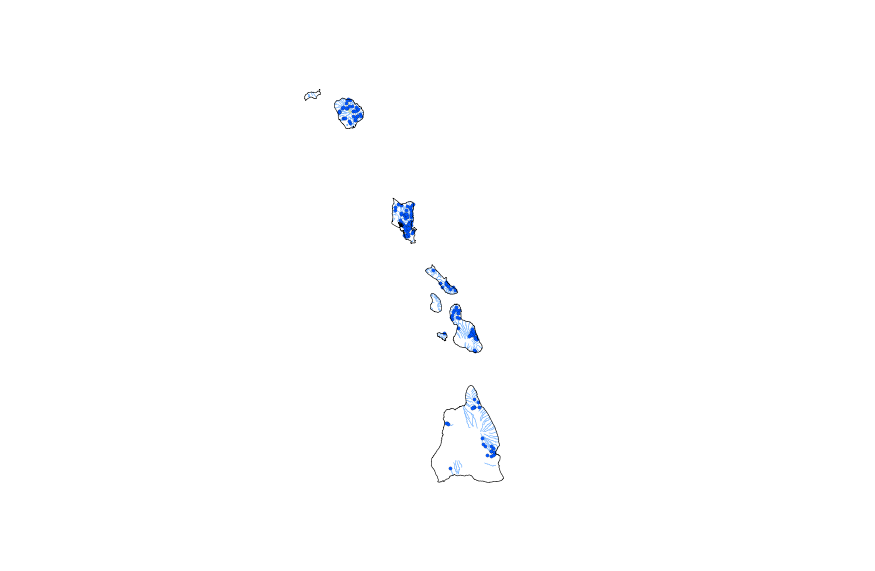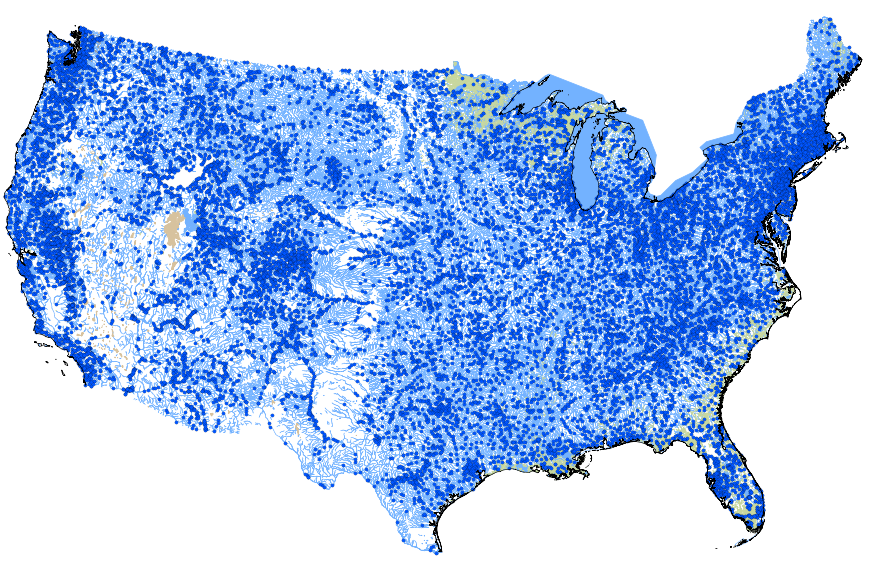Filters: Tags: drainage (X)
102 results (216ms)|
Filters
Date Range
Extensions Types Contacts
Categories Tag Types
|

This geodatabase contains streams, waterbodies and wetlands, streamflow gaging stations, and coastlines for Hawaii. The streams are incorporated into a geometric network. All feature classes are vertically integrated with each other and with 1:1,000,000-scale transportation and boundary data sets.

Rivers, streams, lakes and other water bodies of the Metro region. Downloaded from Metro's RLIS Discovery site on 7/2/2012.

This geospatial dataset is a hydrologic unit boundary layer for the Sub-watershed (12-digit) level. The dataset is a subset of the 6th level (field) hydrologic unit boundaries from the Watershed Boundary Dataset (WBD) layer for Oregon. Hydrologic units in the data set represent drainage areas delineated to the 6th level drainage systems. Their boundaries are defined by hydrographic and topographic criteria that delineate an area of land upstream from a specific point on a river, stream, or similar surface waters. Boundaries within the this data set were delineated by Pacific Northwest (PNW) Hydrography Framework Partners and Natural Resources Conservation Service (NRCS) to meet state requirements and to contribute...
This represents the flowline network in Connecting River Systems Restoration Assessment (CRSRA). It is attributed with the number of disconnections between the reach and the connecting river system. These data will help identify the condition of hydrologic separation between potential restoration areas and the connecting river system. Low numbers represent fewer disconnections such as culverts between the reach and the rivers requiring no flow network modification to restore the area.
Categories: Data;
Types: Citation,
Downloadable,
Map Service,
OGC WFS Layer,
OGC WMS Layer,
Shapefile;
Tags: Artificial Path,
Canal / Ditch,
Detroit River,
FWHydrography,
Great Lakes,
This map service is an information surface representing the dominant class within the soil map unit polygon for soil drainage class. Each component (and therefore soil map unit polygon) falls into one of the following classes according to NRCS: Very Poorly Drained, Poorly Drained, Somewhat Poorly Drained, Moderately Well Drained, Well Drained, Somewhat Excessively Drained and Excessively Drained. Of soil components which make up greater than or equal to 15% of the soil map unit, the wettest component is reported by the map service. Another service exists for drainage class which reports the dominant class in the soil map unit. The concept is similar but for some purposes knowing the dominant component may be...
Categories: Data;
Types: ArcGIS REST Map Service,
Map Service;
Tags: SSURGO,
drainage,
infiltration,
percolate,
permeability,

HydroSHEDS (Hydrological data and maps based on SHuttle Elevation Derivatives at multiple Scales) provides hydrographic information in a consistent and comprehensive format for regional and global-scale applications. HydroSHEDS offers a suite of geo-referenced data sets (vector and raster), including stream networks, watershed boundaries, drainage directions, and ancillary data layers such as flow accumulations, distances, and river topology information. HydroSHEDS is derived from elevation data of the Shuttle Radar Topography Mission (SRTM) at 3 arc-second resolution. Available HydroSHEDS resolutions range from 3 arc-second (approx. 90 meters at the equator) to 5 minute (approx. 10 km at the equator) with seamless...
Map of the Kokolik River Area and location of proposed observation sites (numbered circles). The Kokolik River drains from the northwestern corner of the Brooks Range south and west to Kasegaluk Lagoon and the Chukchi Sea. It crosses the three ecoregions but has very little high elevation area. Inset shows the location of the seven TEON focal watersheds. Image by Arctic LCC staff.
Categories: Data;
Types: Map Service,
OGC WFS Layer,
OGC WMS Layer,
OGC WMS Service;
Tags: AIR TEMPERATURE,
AIR TEMPERATURE,
ATMOSPHERE,
ATMOSPHERE,
Academics & scientific researchers,
This map service is an information surface representing the dominant class within the soil map unit polygon for soil drainage class. Each component (and therefore soil map unit polygon) falls into one of the following classes according to NRCS: Very Poorly Drained, Poorly Drained, Somewhat Poorly Drained, Moderately Well Drained, Well Drained, Somewhat Excessively Drained and Excessively Drained. The class belonging to the component that makes up the highest percentage of the map unit is reported by the map service. Another service exists for drainage class which reports the wettest class in the soil map unit. The concept is similar but for some purposes knowing the wettest component may be the most useful piece...
Categories: Data;
Types: ArcGIS REST Map Service,
Map Service;
Tags: SSURGO,
drainage,
infiltration,
permeability,
porosity,

This geodatabase contains streams, waterbodies and wetlands, streamflow gaging stations, and coastlines for the conterminous United States. The streams are incorporated into a geometric network. All feature classes are vertically integrated with each other and with 1:1,000,000-scale transportation and boundary data sets.

This dataset represents the soil pH from SSURGO and STATSGO soil descriptions for soil map units in the state of southern Alaska that lie within the North Pacific Landscape Conservation Cooperative. Definition The complete definition and official criteria for hydrologic soil groups are available online at (Title 210, National Engineering Handbook, Part 630, Chapter 7, “Hydrologic Soil Groups”). “Hydrologic group” is a group of soils having similar runoff potential under similar storm and cover conditions. Soil properties that influence runoff potential are those that influence the minimum rate of infiltration for a bare soil after prolonged wetting and when not frozen. These properties are depth to a seasonal...

HydroSHEDS (Hydrological data and maps based on SHuttle Elevation Derivatives at multiple Scales) provides hydrographic information in a consistent and comprehensive format for regional and global-scale applications. HydroSHEDS offers a suite of geo-referenced data sets (vector and raster), including stream networks, watershed boundaries, drainage directions, and ancillary data layers such as flow accumulations, distances, and river topology information. HydroSHEDS is derived from elevation data of the Shuttle Radar Topography Mission (SRTM) at 3 arc-second resolution. Available HydroSHEDS resolutions range from 3 arc-second (approx. 90 meters at the equator) to 5 minute (approx. 10 km at the equator) with seamless...

HydroSHEDS (Hydrological data and maps based on SHuttle Elevation Derivatives at multiple Scales) provides hydrographic information in a consistent and comprehensive format for regional and global-scale applications. HydroSHEDS offers a suite of geo-referenced data sets (vector and raster), including stream networks, watershed boundaries, drainage directions, and ancillary data layers such as flow accumulations, distances, and river topology information. HydroSHEDS is derived from elevation data of the Shuttle Radar Topography Mission (SRTM) at 3 arc-second resolution. Available HydroSHEDS resolutions range from 3 arc-second (approx. 90 meters at the equator) to 5 minute (approx. 10 km at the equator) with seamless...

HydroSHEDS (Hydrological data and maps based on SHuttle Elevation Derivatives at multiple Scales) provides hydrographic information in a consistent and comprehensive format for regional and global-scale applications. HydroSHEDS offers a suite of geo-referenced data sets (vector and raster), including stream networks, watershed boundaries, drainage directions, and ancillary data layers such as flow accumulations, distances, and river topology information. HydroSHEDS is derived from elevation data of the Shuttle Radar Topography Mission (SRTM) at 3 arc-second resolution. Available HydroSHEDS resolutions range from 3 arc-second (approx. 90 meters at the equator) to 5 minute (approx. 10 km at the equator) with seamless...
The Terrestrial Environmental Observation Network (TEON) is intended to meet the need for asustainable environmental observing network for northern Alaska. TEON is organized aroundrepresentative focal watersheds (Figure 1). TEON will collect, distribute, and synthesize long-termobservational data needed to detect and forecast effects of a changing climate, hydrology, andpermafrost regime on wildlife, habitat, and infrastructure in northern Alaska.
Categories: Data;
Types: Map Service,
OGC WFS Layer,
OGC WMS Layer,
OGC WMS Service;
Tags: AIR TEMPERATURE,
AIR TEMPERATURE,
ATMOSPHERE,
ATMOSPHERE,
Academics & scientific researchers,
Ideal observation sites are located near tributary-mainstem confluences and provide frequent,synchronous measurements of physical, chemical, and biological attributes. This “nested watershed”design supports characterization of environmental conditions adjacent to the sampling stations, whileinstream hydrological measurements will reflect both local conditions and inputs from upstream. TEON observations sites are stratified by ecoregions, so we can aggregate data sets across the network to characterize conditions at the ecoregion scale.
Categories: Data;
Types: Map Service,
OGC WFS Layer,
OGC WMS Layer,
OGC WMS Service;
Tags: AIR TEMPERATURE,
AIR TEMPERATURE,
ATMOSPHERE,
ATMOSPHERE,
Academics & scientific researchers,
This dataset is the output of a python script/ArcGIS model that identifes dikes as having a difference in elevation above a certain threshold. If the elevation difference was below a certain threshold the area was not considered a dike; however, if the difference in elevation between two points was significantly high then the area was marked as a dike. Areas continuous with eachother were considered part of the same dike. Post processing occured. Users examined the data output, comparing the proposed dike locations to aerial imagery, flowline data, and the DEM. Dikes that appeared to be false positives were deleted from the data set.
Categories: Data;
Types: Citation,
Downloadable,
Map Service,
OGC WFS Layer,
OGC WMS Layer,
Shapefile;
Tags: Great Lakes,
LIDAR,
Saginaw Bay,
biogeography,
coastal ecosystems,
This represents the flowline network in Sagina Bay Restoration Assessment (SBRA). It is attributed with the number of disconnections between the reach and the connecting river system. These data will help identify the condition of hydrologic separation between potential restoration areas and the connecting river system. Low numbers represent fewer disconnections such as culverts between the reach and the rivers requiring no flow network modification to restore the area.
Categories: Data;
Types: Citation,
Downloadable,
Map Service,
OGC WFS Layer,
OGC WMS Layer,
Shapefile;
Tags: Artificial Path,
Canal / Ditch,
FWHydrography,
Great Lakes,
Hydrography,
PEM_Projects contains Predictive Ecosystem Mapping (PEM) project boundaries (study areas) and attributes describing each project (project level metadata), plus links to the locations of other data associated with the project (e.g., reports, polygon datasets, plotfiles, legends). PEM uses modeling to divide the landscape into units according to a variety of ecological features including climate, physiography, surficial material, bedrock geology, soils and vegetation. This layer is derived from the STE_TEI_PROJECT_BOUNDARIES_SP layer by filtering on the PROJECT_TYPE attribute

This dataset represents the soil hydrologic group from SSURGO and STATSGO soil descriptions for soil map units in the state of northern California that lie within the North Pacific Landscape Conservation Cooperative. Definition The complete definition and official criteria for hydrologic soil groups are available online at (Title 210, National Engineering Handbook, Part 630, Chapter 7, “Hydrologic Soil Groups”). “Hydrologic group” is a group of soils having similar runoff potential under similar storm and cover conditions. Soil properties that influence runoff potential are those that influence the minimum rate of infiltration for a bare soil after prolonged wetting and when not frozen. These properties are...

HydroSHEDS (Hydrological data and maps based on SHuttle Elevation Derivatives at multiple Scales) provides hydrographic information in a consistent and comprehensive format for regional and global-scale applications. HydroSHEDS offers a suite of geo-referenced data sets (vector and raster), including stream networks, watershed boundaries, drainage directions, and ancillary data layers such as flow accumulations, distances, and river topology information. HydroSHEDS is derived from elevation data of the Shuttle Radar Topography Mission (SRTM) at 3 arc-second resolution. Available HydroSHEDS resolutions range from 3 arc-second (approx. 90 meters at the equator) to 5 minute (approx. 10 km at the equator) with seamless...
|

|